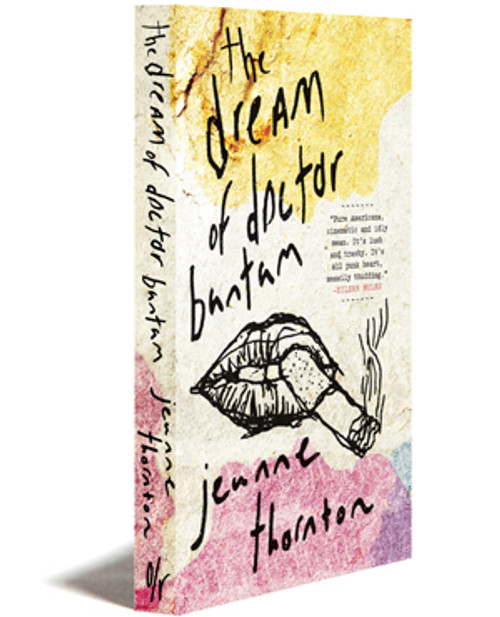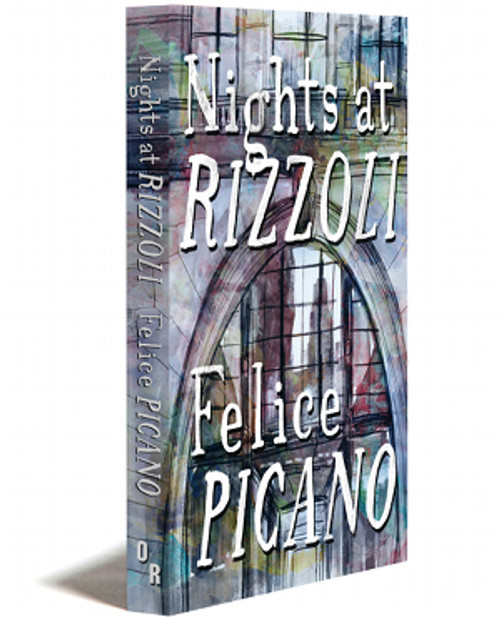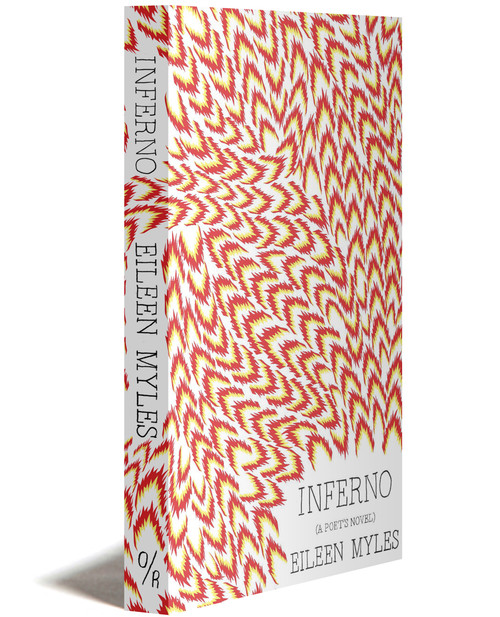The Dream of Doctor Bantam
“All punk heart, messily thudding.”
—Eileen Mylesabout the bookabout
Jeanne Thornton’s debut novel is a love story unlike any other, featuring Julie Thatch, a tough-as-nails, chainsmoking, wise-cracking 17-year-old Texan. Her idol, her older sister, jogs headlong into the lights of an approaching car, and dies. And Julie falls in love with a girl who both is and isn’t an echo of her older sister, a long-limbed Francophone named Patrice—who is also a devotee of the Institute of Temporal Illusions, a Church of Scientology-like cult.
In Julie Thatch you cannot help but see shades of Stieg Larsson’s Lisbeth Salander. Jeanne’s former writing teacher at the University of Texas, Alexander Parsons (author of Leaving Disneyland and In the Shadows of the Sun) writes: “The Dream of Doctor Bantam is one of those books you read every few years in which, page by page, you come to think of the characters as a part of your own dear, weird, and intransigent family. In Julie Thatch, Thornton has written a character as memorable and compelling as Holden Caufield or Oedipa Maas. She is alternately hilarious, maddening, and enchanting, a fearful and fearless smartass who enlivens every page of this fine novel.”
With illustrations by the author.
“Jeanne Thornton’s incredibly surprising and awkward novel falls into an improbable space that feels like the terrible school of Robert Walser’s Jakob Von Gunten and also the acid-laced wooded setting of Angela Carter’s novella Love. Yet Thornton's Dr. Bantam is pure Americana, cinematic and idly mean. It’s lush and trashy. I guess it’s the most graphic-novelly feeling book about loss I can think of. It’s all punk heart, messily thudding.”
—Eileen Myles
“Jeanne Thornton has a novel coming out this year that you will read and love. It is called The Dream of Dr. Bantam. Google this title every day until it pops up in your face for sale, like a toaster pastry in a commercial where the children have gel in their hair.”
—Miracle Jones
About The Author / Editor
Preview
The curbs in West Campus were covered with grass, rarely-mowed and hanging, concealing secret cities of insects. Above, the low-slung telephone wires crashed into the tops of trees. Everywhere nature was fighting civilization. On the porch of a commune along Rio Grande three twenty-somethings were smoking pot and barbecuing thick-smelling vegetables; they waved to Julie as she walked by, en route to Ira’s to meet this cult girl for real this time, the polo shirt she’d worn in eighth grade to the science fair regionals buttoned up to her neck. She didn’t wave back; they were wasting their lives.
A spreading Bradford pear stained the Bermuda grass around Ira’s house blue in the late-May light. The house was old, 1970s, with a chain-link fence that squeezed out all sides of the rotting railing that closed in the porch. Flaking blue paint lined the wooden walls and there were spider webs between the slats, and a propped-up bike without a lock rested against the porch stairs. A white plastic table with a chessboard print bore a full ashtray centered two squares ahead of Queen’s pawn, and there was a rusted wire shelf lined with the usual junk: a garden trowel caked in mud, empty terra cotta pots, forgotten photograph frames, a pocket notebook short-edge bound in wire with no cover and CALL ABOUT JOB written in ballpoint pen with no number, no explanation.
There were two doors. One of them led to the ground floor, the crack between porch and jamb guarded by a welcome mat with a Wolf Man print and flanked by a wide poster of a marijuana leaf and a Victor Moscoso print in nauseating stereographic orange. The other door led up.
She stood on the Wolf Man welcome mat and knocked on Ira’s door, then paced the deck as she waited, looking through the window of the door leading upstairs. Varicolored Christmas lights ran around the inside of the door frame, climbed the baseboards and looped along the railing of the carpeted staircase on their way to frame the door to the apartment at the top. She knocked on Ira’s door again: no answer.
God damn you, asshole, she hissed, and rattled the doorknob, open the door, open the door; I want to meet this cult girl already—
She could hear faint guitar solos, honest and real-sounding, coming from somewhere at the back of the house. She bit her lip, hard, and tried to circle the porch, looking for a likely window, but then stopped. The door to the second floor was open.
She told herself that she would go back down any second now as she climbed the steps. She’d just go up the first step; no, she’d go up halfway; no, she’d go up until she heard a creak. Photographs of Paris streets, no frames to them, had been Scotch-taped at even intervals along the narrow walls; reflections of pink, yellow, green, and blue glowed in the gloss of each black-and-white print. She tried to figure out exactly what was so unwholesome about this; it had something to do with the way you couldn’t see the lights from outside, something to do with the way they were decorations for an exclusively private audience. She left the door open to the porch as she climbed. Each step had an echo and from somewhere below the staircase she swore she could hear the rust and springs.
in the media
The Dream of Doctor Bantam
“All punk heart, messily thudding.”
—Eileen Mylesabout the bookabout
Jeanne Thornton’s debut novel is a love story unlike any other, featuring Julie Thatch, a tough-as-nails, chainsmoking, wise-cracking 17-year-old Texan. Her idol, her older sister, jogs headlong into the lights of an approaching car, and dies. And Julie falls in love with a girl who both is and isn’t an echo of her older sister, a long-limbed Francophone named Patrice—who is also a devotee of the Institute of Temporal Illusions, a Church of Scientology-like cult.
In Julie Thatch you cannot help but see shades of Stieg Larsson’s Lisbeth Salander. Jeanne’s former writing teacher at the University of Texas, Alexander Parsons (author of Leaving Disneyland and In the Shadows of the Sun) writes: “The Dream of Doctor Bantam is one of those books you read every few years in which, page by page, you come to think of the characters as a part of your own dear, weird, and intransigent family. In Julie Thatch, Thornton has written a character as memorable and compelling as Holden Caufield or Oedipa Maas. She is alternately hilarious, maddening, and enchanting, a fearful and fearless smartass who enlivens every page of this fine novel.”
With illustrations by the author.
“Jeanne Thornton’s incredibly surprising and awkward novel falls into an improbable space that feels like the terrible school of Robert Walser’s Jakob Von Gunten and also the acid-laced wooded setting of Angela Carter’s novella Love. Yet Thornton's Dr. Bantam is pure Americana, cinematic and idly mean. It’s lush and trashy. I guess it’s the most graphic-novelly feeling book about loss I can think of. It’s all punk heart, messily thudding.”
—Eileen Myles
“Jeanne Thornton has a novel coming out this year that you will read and love. It is called The Dream of Dr. Bantam. Google this title every day until it pops up in your face for sale, like a toaster pastry in a commercial where the children have gel in their hair.”
—Miracle Jones
About The Author / Editor
Preview
The curbs in West Campus were covered with grass, rarely-mowed and hanging, concealing secret cities of insects. Above, the low-slung telephone wires crashed into the tops of trees. Everywhere nature was fighting civilization. On the porch of a commune along Rio Grande three twenty-somethings were smoking pot and barbecuing thick-smelling vegetables; they waved to Julie as she walked by, en route to Ira’s to meet this cult girl for real this time, the polo shirt she’d worn in eighth grade to the science fair regionals buttoned up to her neck. She didn’t wave back; they were wasting their lives.
A spreading Bradford pear stained the Bermuda grass around Ira’s house blue in the late-May light. The house was old, 1970s, with a chain-link fence that squeezed out all sides of the rotting railing that closed in the porch. Flaking blue paint lined the wooden walls and there were spider webs between the slats, and a propped-up bike without a lock rested against the porch stairs. A white plastic table with a chessboard print bore a full ashtray centered two squares ahead of Queen’s pawn, and there was a rusted wire shelf lined with the usual junk: a garden trowel caked in mud, empty terra cotta pots, forgotten photograph frames, a pocket notebook short-edge bound in wire with no cover and CALL ABOUT JOB written in ballpoint pen with no number, no explanation.
There were two doors. One of them led to the ground floor, the crack between porch and jamb guarded by a welcome mat with a Wolf Man print and flanked by a wide poster of a marijuana leaf and a Victor Moscoso print in nauseating stereographic orange. The other door led up.
She stood on the Wolf Man welcome mat and knocked on Ira’s door, then paced the deck as she waited, looking through the window of the door leading upstairs. Varicolored Christmas lights ran around the inside of the door frame, climbed the baseboards and looped along the railing of the carpeted staircase on their way to frame the door to the apartment at the top. She knocked on Ira’s door again: no answer.
God damn you, asshole, she hissed, and rattled the doorknob, open the door, open the door; I want to meet this cult girl already—
She could hear faint guitar solos, honest and real-sounding, coming from somewhere at the back of the house. She bit her lip, hard, and tried to circle the porch, looking for a likely window, but then stopped. The door to the second floor was open.
She told herself that she would go back down any second now as she climbed the steps. She’d just go up the first step; no, she’d go up halfway; no, she’d go up until she heard a creak. Photographs of Paris streets, no frames to them, had been Scotch-taped at even intervals along the narrow walls; reflections of pink, yellow, green, and blue glowed in the gloss of each black-and-white print. She tried to figure out exactly what was so unwholesome about this; it had something to do with the way you couldn’t see the lights from outside, something to do with the way they were decorations for an exclusively private audience. She left the door open to the porch as she climbed. Each step had an echo and from somewhere below the staircase she swore she could hear the rust and springs.









